Archean Zircons with Omphacite Inclusions from Eclogites of the Belomorian Province, Fennoscandian Shield: The First Finding
Abstract
:1. Introduction
2. Geological Setting
3. Petrological and Geochronological Outline
4. Analytical Methods
5. Results
5.1. Zircon Morphology
5.2. Zircon Isotope Ages
5.3. Zircon Geochemistry
5.4. Mineral Inclusions
6. Discussion
7. Conclusions
Author Contributions
Funding
Acknowledgments
Conflicts of Interest
References
- De Wit, M.J. On Archean granites, greenstones, cratons and tectonics: Does the evidence demand a verdict? Precambrian Res. 1998, 91, 181–226. [Google Scholar] [CrossRef]
- Griffin, W.L.; O’Reilly, S.Y.; Abe, N.; Aulbach, S.; Davies, R.M.; Pearson, N.J.; Doyle, B.J.; Kivi, K. The origin and evolution of Archean lithospheric mantle. Precambrian Res. 2003, 127, 19–41. [Google Scholar] [CrossRef]
- Rozen, O.M.; Shchipansky, A.A.; Turkina, O.M. Geodynamics of the Early Earth: Evolution and Stability of Geological Processes; Nauchyi Mir: Moscow, Russia, 2008; p. 184. (In Russian) [Google Scholar]
- Davies, G.F. Gravitational depletion of the early Earth’s upper mantle and the viability of early plate tectonics. Earth Planet. Sci. Lett. 2006, 243, 376–382. [Google Scholar] [CrossRef]
- Brown, M. Duality of thermal regimes is the distinctive characteristic of plate tectonics since the Neoarchean. Geology 2006, 34, 961–964. [Google Scholar] [CrossRef]
- Brown, M. Metamorphic Conditions in Orogenic Belts: A Record of Secular Change. Int. Geol. Rev. 2007, 49, 193–234. [Google Scholar] [CrossRef]
- O’Neill, C.; Lenardic, A.; Moresi, L.; Torsvik, T.H.; Lee, C.-T.A. Episodic Precambrian subduction. Earth Planet. Sci. Lett. 2007, 262, 552–562. [Google Scholar] [CrossRef]
- Condie, K.C.; Pease, V.V. When Did Plate Tectonics Begin on Planet Earth? Geological Society of America: Boulder, CO, USA, 2008; Volume 440, p. 294. [Google Scholar]
- Shirey, S.B.; Richardson, S.H.; Harris, J.W. Mesoarchean to Mesoproterozoic Re-Os ages for sulfide inclusions in Orapa diamonds and implications for Kaapvaal-Zimbabwe craton development. In 9th International Kimberlite Conference. Extended Abstract; IKZ: Frankfurt, Germany, 2008; 9IKC-A-00365. [Google Scholar]
- van Hunen, J.; van den Berg, A. Plate tectonics on the early Earth: Limitations imposed by strength and buoyancy of subducted lithosphere. Lithos 2008, 103, 217–235. [Google Scholar] [CrossRef]
- Sizova, E.; Gerya, T.; Brown, M.; Perchuk, L.L. Subduction styles in the Precambrian: Insight from numerical experiments. Lithos 2010, 116, 209–229. [Google Scholar] [CrossRef] [Green Version]
- Dobretsov, N.L.; Turkina, O.M. Early Precambrian Earth history: Plate and plume tectonics and extraterrestrial controls. Russ. Geol. Geophys. 2015, 56, 978–995. [Google Scholar] [CrossRef]
- Windley, B.F.; Kusky, T.; Polat, A. Onset of plate tectonics by the Eoarchean. Precambrian Res. 2021, 35, 105980. [Google Scholar] [CrossRef]
- Volodichev, O.I.; Slabunov, A.I.; Bibikova, E.V.; Konilov, A.N.; Kuzenko, T.I. Archean eclogites in the Belomorian mobile belt, Baltic Shield. Petrology 2004, 12, 540–560. [Google Scholar]
- Shchipansky, A.A.; Khodorevskaya, L.I.; Konilov, A.N.; Slabunov, A.I. Eclogites from the Belomorian Mobile Belt (Kola Peninsula): Geology and petrology. Russ. Geol. Geophys. 2012, 53, 1–21. [Google Scholar] [CrossRef]
- Shchipansky, A.A.; Khodorevskaya, L.I.; Slabunov, A.I. The geochemistry and isotopic age of eclogites from the Belomorian Belt (Kola Peninsula): Evidence for subducted Archean oceanic crust. Russ. Geol. Geophys. 2012, 53, 262–280. [Google Scholar] [CrossRef]
- Mints, M.V.; Belousova, E.A.; Konilov, A.N.; Natapov, L.M.; Shchipansky, A.A.; Griffin, W.L.; O’Reilly, S.Y.; Dokukina, K.A.; Kaulina, T.V. Mesoarchean subduction processes: 2.87 Ga eclogites from the Kola Peninsula, Russia. Geology 2010, 38, 739–742. [Google Scholar] [CrossRef]
- Saha, L.; Pant, N.C.; Pati, J.K.; Upadhyay, D.; Berndt, J.; Bhattacharya, A.; Satynarayanan, M. Neoarchean high-pressure margarite–phengitic muscovite–chlorite corona mantled corundum in quartz-free high-Mg, al phlogopite–chlorite schists from the Bundelkhand Craton, north Central India. Contrib. Miner. Petrol. 2011, 161, 511–530. [Google Scholar] [CrossRef]
- Brown, M.; Johnson, T. Secular change in metamorphism and the onset of global plate tectonics. Am. Miner. 2018, 103, 181–196. [Google Scholar] [CrossRef]
- Möller, A.; Appel, P.; Mezger, K.; Schenk, V. Evidence for a 2.0 Ga subductionzone: Eclogites in the Usagaran belt of Tanzania. Geology 1995, 12, 1067–1070. [Google Scholar] [CrossRef]
- Baldwin, J.A.; Bowring, S.A.; Williams, M.L.; Williams, I.S. Eclogites of the Snowbird Tectonic Zone: Petrological and U-Pb geochronological evidence for Paleoproterozoic high-pressure metamorphism in the western Canadian Shield. Contrib. Miner. Petrol. 2004, 147, 528–548. [Google Scholar] [CrossRef]
- Skublov, S.G.; Astaf’ev, B.Y.; Marin, Y.B.; Berezin, A.V.; Mel’nik, A.E.; Presnyakov, S.L. New data on the age of eclogites from the Belomorian Mobile Belt at Gridino settlement area. Dokl. Earth Sci. 2011, 439, 1163–1170. [Google Scholar] [CrossRef]
- Herwartz, D.; Skublov, S.G.; Berezin, A.V.; Mel’nik, A.E. First Lu–Hf Garnet Ages of Eclogites from the Belomorian Mobile Belt (Baltic Shield, Russia). Dokl. Earth Sci. 2012, 443, 377–380. [Google Scholar] [CrossRef]
- Yu, H.L.; Zhang, L.F.; Wei, C.J.; Li, X.L.; Guo, J.H. Age and P-T Conditions of the Gridino eclogite in the Belomorian Province, Russia. J. Metamorph. Geol. 2017, 35, 855–869. [Google Scholar] [CrossRef]
- Yu, H.; Zhang, L.; Lanari, P.; Rubatto, D.; Li, X. Garnet Lu-Hf geochronology and P-T path of the Gridino-type eclogite in the Belomorian Province, Russia. Lithos 2019, 326, 313–326. [Google Scholar] [CrossRef]
- Melnik, A.E.; Skublov, S.G.; Rubatto, D.; Müller, D.; Li, X.-H.; Li, Q.-L.; Berezin, A.V.; Herwartz, D.; Machevariani, M.M. Garnet and zircon geochronology of the Paleoproterozoic Kuru-Vaara eclogites, northern Belomorian Province, Fennoscandian Shield. Precambrian Res. 2021, 353, 106014. [Google Scholar] [CrossRef]
- Balagansky, V.V.; Maksimov, O.A.; Gorbunov, I.A.; Kartushinskaya, T.V.; Mudruk, S.V.; Sidorov, M.Y.; Sibelev, O.S.; Volodichev, O.I.; Stepanova, A.V.; Stepanov, V.S.; et al. Archean and Paleoproterozoic eclogites and zoisitites in the Gridino area. In Early Precambrian Eclogites of the Belomorian Province, Fennoscandian Shield. Field Guidebook; Slabunov, A.I., Balagansky, V.V., Shchipansky, A.A., Eds.; KRC RAS: Petrozavodsk, Russia, 2019; pp. 11–48. [Google Scholar]
- Babarina, I.I.; Sibelev, O.S. Deformation events in the Gridino zone, Belomorian Province, Fennoscandian Shield: Relationships between mafic dike swarms and eclogite-bearing mélange. Int. Geol. Rev. 2015, 57, 1605–1616. [Google Scholar] [CrossRef]
- Balagansky, V.; Shchipansky, A.; Slabunov, A.; Gorbunov, I.; Mudruk, S.; Sidorov, M.; Azimov, P.; Egorova, S.; Stepanova, A.; Voloshin, A. Archean Kuru-Vaara eclogites in the northern Belomorian Province, Fennoscandian Shield: Crustal architecture, timing and tectonic implications. Int. Geol. Rev. 2015, 57, 1543–1565. [Google Scholar] [CrossRef]
- Slabunov, A.I.; Burdyukh, E.V.; Babarina, I.I. Granulometry and spatial distribution of fragmented components of the Gridino eclogite-bearing mélange. Geol. Miner. Karelia 2007, 10, 27–34. (In Russian) [Google Scholar]
- Sibelev, O.S. Gridino zone of mélange (Belomorian Mobile Belt): Geology and structure. Geol. Miner. Karelia 2012, 15, 28–37. (In Russian) [Google Scholar]
- Volodichev, O.I.; Slabunov, A.I.; Sibelev, O.S.; Skublov, S.G.; Kuzenko, T.I. Geochronology, Mineral Inclusions, and Geochemistry of Zircons in Eclogitized Gabbronorites in the Gridino Area, Belomorian Province. Geochem. Int. 2012, 50, 657–670. [Google Scholar] [CrossRef]
- Kozlovskii, V.M.; Aranovich, L.Y. Petrology and thermobarometry of eclogite rocks in the Krasnaya Guba dike field, Belomorian Mobile Belt. Petrology 2010, 18, 27–49. [Google Scholar] [CrossRef]
- Berezin, A.V.; Travin, V.V.; Marin, Y.B.; Skublov, S.G.; Bogomolov, E.S. New U–Pb and Sm–Nd ages and P–T estimates for eclogitization in the Fe-Rich gabbro dyke in Gridino area (Belomorian Mobile Belt). Dokl. Earth Sci. 2012, 444, 760–765. [Google Scholar] [CrossRef]
- Mints, M.V.; Dokukina, K.A. Age of eclogites formed by the subduction of the Mesoarchaean oceanic crust (Salma, Belomorian Eclogite Province, eastern Fennoscandian Shield, Russia): A synthesis. Precambrian Res. 2020, 350, 105879. [Google Scholar] [CrossRef]
- Mints, M.V.; Dokukina, K.A. Reply to comments from S.G. Skublov, A.V. Berezin, and L.I. Salimgaraeva on the article authored by M.V. Mints and K.A. Dokukina—The Belomorian eclogite province (Eastern Fennoscandian shield, Russia): Meso-Neoarchean or Late Paleoproterozoic? Geodyn. Tectonophys. 2021, 12, 662–667. [Google Scholar] [CrossRef]
- Slabunov, A.I.; Balagansky, V.V.; Shchipansky, A.A. Mesoarchean to Paleoproterozoic crustal evolution of the Belomorian Province, Fennoscandian Shield, and the tectonic setting of eclogites. Russ. Geol. Geophys. 2021, 62, 525–546. [Google Scholar] [CrossRef]
- Skublov, S.G.; Berezin, A.V.; Berezhnaya, N.G. General Relations in the Trace Element Composition of Zircons from Eclogites with Implications for the Age of Eclogites in the Belomorian Mobile Belt. Petrology 2012, 20, 427–449. [Google Scholar] [CrossRef]
- Rubatto, D. Zircon trace element geochemistry: Partitioning with garnet and the link between U–Pb ages and metamorphism. Chem. Geol. 2002, 184, 123–138. [Google Scholar] [CrossRef]
- Slabunov, A.I. Geology and Geodynamics of the Archean Mobile Belts Exemplified on Belomorian Province of the Fennoscandian Shield; KRC RAS: Petrozavodsk, Russian, 2008; p. 296. (In Russian) [Google Scholar]
- Slabunov, A.I.; Lobach-Zhuchenko, S.B.; Bibikova, E.V.; Sorjonen-Ward, P.; Balagansky, V.V.; Volodichev, O.I.; Shchipansky, A.A.; Svetov, S.A.; Chekulaev, V.P.; Arestova, N.A.; et al. The Archaean nucleus of the Fennoscandian (Baltic) Shield. Mem. Geol. Soc. Lond. 2006, 32, 627–644. [Google Scholar] [CrossRef]
- Daly, J.S.; Balagansky, V.V.; Timmerman, M.J.; Whitehouse, M.J. The Lapland-Kola orogen: Palaeoproterozoic collision and accretion of the northern Fennoscandian lithosphere. Mem. Geol. Soc. Lond. 2006, 32, 579–598. [Google Scholar] [CrossRef]
- Lahtinen, R.; Huhma, H. A revised geodynamic model for the Lapland-Kola Orogen. Precambrian Res. 2019, 330, 1–19. [Google Scholar] [CrossRef]
- Hölttä, P.; Huhma, H.; Lahaye, Y.; Mänttäri, I.; Lukkari, S.; O’Brien, H. Paleoproterozoic metamorphism in the northern Fennoscandian Shield: Age constraints revealed by monazite. Int. Geol. Rev. 2020, 62, 360–387. [Google Scholar] [CrossRef]
- Balagansky, V.V.; Gorbunov, I.A.; Mudruk, S.V. Palaeoproterozoic Lapland-Kola and Svecofennian orogens (Baltic shield). Her. Kola Sci. Cent. RAS 2016, 3, 5–11, (In Russian with English Abstract). [Google Scholar]
- Volodichev, O.I.; Kuzenko, T.I.; Maksimov, O.A. Geology and petrology of zoisitites from the Gridino eclogite-bearing complex, Belomorian province, Fennoscandian shield. Trans. KRC RAS. Precambrian. Geol. Ser. 2020, 10, 26–48. (In Russian) [Google Scholar]
- Morgunova, A.A.; Perchuk, A.L. Petrology of Precambrian metaultramafites of the Gridino high-pressure complex (Karelia). Russ. Geol. Geophys. 2012, 53, 131–146. [Google Scholar] [CrossRef]
- Maksimov, O.A. Metamorphic evolution of pyroxenites from the Gridino eclogite- bearing complex (Pryanishnaya Luda Island). Vestn. MSTU 2014, 17, 320–328. (In Russian) [Google Scholar]
- Stepanova, A.; Stepanov, V.; Larionov, A.; Salnikova, E.; Samsonov, A.; Azimov, P.; Egorova, S.; Babarina, I.; Larionova, Y.; Sukhanova, M.; et al. Relicts of Paleoproterozoic LIPs in the Belomorian province, eastern Fennoscandian Shield: Barcode reconstruction for a deeply eroded collisional orogeny. In Large Igneous Provinces and Their Plumbing Systems. Geological Society of London Special Publications; Srivastava, R.K., Ernst, R.E., Buchan, K.L., De Kock, M., Eds.; Geological Society of London: London, UK, 2021; p. 518. [Google Scholar] [CrossRef]
- Stepanov, V.S.; Stepanova, A.V. Early Paleoproterozoic metagabbroids of the Gridino village area (Belomorian mobile belt). Geol. Miner. Karelia 2006, 9, 57–71. (In Russian) [Google Scholar]
- Slabunov, A.I.; Volodichev, O.I.; Skublov, S.G.; Berezin, A.V. Main Stages of the Formation of Paleoproterozoic Eclogitized Gabbro-Norite: Evidence from U–Pb (SHRIMP) Dating of Zircons and Study of Their Genesis. Dokl. Earth Sci. 2011, 437, 396–400. [Google Scholar] [CrossRef]
- Volodichev, O.I. The Belomorian Complex of Karelia (Geology and Petrology); Nauka: Leningrad, Russia, 1990; p. 248. [Google Scholar]
- Makarizhin, V.V.; Medvedev, P.V.; Richancik, D.V. Geological Sites of Karelia; KRC RAS: Petrozavodsk, Russia, 2006; p. 192. (In Russian) [Google Scholar]
- Volodichev, O.I.; Slabunov, A.I.; Stepanov, V.S.; Sibelev, O.S.; Travin, V.V.; Stepanova, A.V.; Babarina, I.I. Archean and Paleoproterozoic eclogites and Paleoproterozoic druzites, Gridino area, White sea. In Belomorian Mobile Belt and It’s Analogues: Geology, Geochronology, Geodynamics and Metallogeny. Field Guidebook and Extended Abstracts; KRC RAS: Petrozavodsk, Russia, 2005; pp. 60–80. [Google Scholar]
- Slabunov, A.I.; Volodichev, O.I.; Stepanova, A.V.; Sibelev, O.S.; Stepanov, V.S.; Babarina, I.I. Archean eclogites and Paleoproterozoic eclogitized gabbroids, Gridino area, White Sea. In Karelian Craton Transect (Finland, Russia): Precambrian Greenstone Belts, Ophiolites and Eclogites; Peltonen, P., Hölttä, P., Slabunov, A., Eds.; 33 IGC, The Nordic Countries: Oslo, Norway, 2008; pp. 36–53. [Google Scholar]
- Volodichev, O.I.; Slabunov, A.I.; Stepanova, A.V.; Stepanov, V.S.; Sibelev, O.S. Archean eclogites and Paleoproterozoic eclogitized gabbroids, Gridino area, White sea. In Precambrian High-Grade Mobile Belts. Belomorian Mobile Belt in the Eastern Fennoscandian Shield. Field Guidebook; KRC RAS: Petrozavodsk, Russia, 2014; pp. 7–32. [Google Scholar]
- Li, X.L.; Zhang, L.F.; Wei, C.J.; Slabunov, A.I. Metamorphic PT path and zircon U-Pb dating of Archean eclogite association in Gridino complex, Belomorian province, Russia. Precambrian Res. 2015, 268, 74–96. [Google Scholar] [CrossRef]
- Skublov, S.G.; Berezin, A.V.; Li, X.-H.; Li, Q.-L.; Salimgaraeva, L.I.; Travin, V.V.; Rezvukhin, D.I. Zircons from a Pegmatite Cutting Eclogite (Gridino, Belomorian Mobile Belt): U-Pb-O and Trace Element Constraints on Eclogite Metamorphism and Fluid Activity. Geosciences 2020, 10, 197. [Google Scholar] [CrossRef]
- Dokukina, K.A.; Konilov, A.N. Metamorphic evolution of the Gridino mafic dyke swarm (Belomorian eclogite province, Russia). In Ultrahigh-Pressure Metamorphism. 25 Years after the Discovery of Coesite and Diamond; Dobrzhinetskaya, L., Cuthbert, S., Faryad, W., Wallis, S., Eds.; Elsevier: Amsterdam, The Netherlands, 2011; pp. 579–621. [Google Scholar]
- Dokukina, K.A.; Bayanova, T.B.; Kaulina, T.V.; Travin, A.V.; Mints, M.V.; Konilov, A.N.; Serov, P.A. The Belomorian eclogite province: Sequence of events and age of the igneous and metamorphic rocks of the Gridino association. Russ. Geol. Geophys. 2012, 53, 1023–1054. [Google Scholar] [CrossRef]
- Volodichev, O.I.; Kuzenko, T.I. Prograde and petrograde trends in evoluyion of archean eclogites metamorphism and their geodynamic interpretation (Karelia, Gridino village area). Proc. Russia Miner. Soc. 2013, 3, 28–51. (In Russian) [Google Scholar]
- Perchuk, A.L.; Morgunova, A.A. Variable P–T paths and HP-UHP metamorphism in a Precambrian terrane, Gridino, Russia: Petrological evidence and geodynamic implications. Gondwana Res. 2014, 25, 614–629. [Google Scholar] [CrossRef]
- Maksimov, O.A. Geology and petrology of eclogites in the Samylino area (Belomorian Province of the Fennoscandian Shield). Trans. KRC RAS. Precambrian Geol. Ser. 2019, 2, 88–94. (In Russian) [Google Scholar] [CrossRef] [Green Version]
- Volodichev, O.I. Evolution of metamorphic processes in the Belomorian mobile belt. In Precambrian High-Grade Mobile Belts. Extendend Abstracts; KRC RAS: Petrozavodsk, Russia, 2014; pp. 115–116. [Google Scholar]
- Kretz, R. Symbols for rock-forming mineral. Amer. Miner. 1983, 68, 277–279. [Google Scholar]
- Maksimov, O.A.; Slabunov, A.I.; Balagansky, V.V.; Volodichev, O.I. Archean eclogites from the Belomorian Province (examples from the Gridino area). In Abstract Volume of the 13th International Eclogite Conference; KRC RAS: Petrozavodsk, Russia, 2019; p. 54. [Google Scholar]
- Kaulina, T.V.; Mitrofanov, F.P.; Apanasevich, E.A.; Zhavkov, V.A.; D’yakov, S.N.; Sherstennikova, O.G. U-Pb dating of garnet. In New Data on Geology and Mineral Deposits of the Kola Peninsula; Mitrofanov, F.P., Ed.; Kola Science Centre of the RAS: Apatity, Russia, 2005; pp. 60–64. (In Russian) [Google Scholar]
- Powell, R. Regression diagnostics and robust regression in geothermometer/geobarometer calibration: The garnet-clinopyroxene geothermometer revised. J. Metamorph. Geol. 1985, 3, 231–243. [Google Scholar] [CrossRef]
- Wells, P.R.A. P-T conditions in the Moines of the Central Highlands, Scotland. J. Geol. Soc. Lond. 1979, 136, 663–671. [Google Scholar] [CrossRef]
- Blundy, J.D.; Holland, T.J.B. Calcic amphibole equilibria and a new amphibole-plagioclase geothermometer. Contrib. Miner. Petrol. 1990, 104, 208–224. [Google Scholar] [CrossRef]
- Holland, T.J.B. The reaction albite = jadeite + quartz determined experimentally in the range 600–1200 °C. Amer. Miner. 1980, 65, 129–134. [Google Scholar]
- Hollister, L.S.; Grissom, G.C.; Peters, E.K.; Stowell, H.H.; Sisson, V.B. Confirmation of the empirical correlation of Al in hornblende with pressure of solidification of calc-alkaline plutons. Amer. Miner. 1987, 72, 231–239. [Google Scholar]
- Berman, R.G. Thermobarometry using multiequilibrium calculations: A new technique, with petrological applications. Can. Miner. 1991, 29, 833–855. [Google Scholar]
- Söderlund, U.; Johansson, L. A simple way to extract baddeleyite (ZrO2). Geochem. Geophys. Geosyst. 2002, 3. [Google Scholar] [CrossRef]
- Williams, I.S. U-Th-Pb Geochronology by Ion Microprobe. In Applications of Microanalytical Techniques to Understanding Mineralizing Processes. Reviews in Economic Geology; McKibben, M.A., Shanks, W.C., III, Ridley, W.I., Eds.; Society of Economic Geologist: Denver, CO, USA, 1998; Volume 7, pp. 1–35. [Google Scholar]
- Larionov, A.N.; Andreichev, V.A.; Gee, D.G. The Vendian alkaline igneous suite of northern Timan: Ion microprobe U-Pb zircon ages of gabbros and syenite. Mem. Geol. Soc. Lon. 2004, 30, 69–74. [Google Scholar] [CrossRef]
- Wiedenbeck, M.; Allé, P.; Corfu, F.; Griffin, W.L.; Meier, M.; Oberli, F.; von Quadt, A.; Roddick, J.C.; Spiegel, W. Three natural zircon standards for U-Th-Pb, Lu-Hf, trace element and REE analyses. Geostand. Newslett. 1995, 19, 1–23. [Google Scholar] [CrossRef]
- Black, L.P.; Kamo, S.L.; Allen, C.M.; Aleinikoff, J.N.; Davis, D.W.; Korsch, R.J.; Foudoulis, C. TEMORA 1: A new zircon standart for Phanerozoic U-Pb geochronology. Chem. Geol. 2003, 200, 155–170. [Google Scholar] [CrossRef]
- Ludwig, K.R. User’s Manual for Isoplot 3.75–4.15: A Geochronological Toolkit for Microsoft Excel; Berkeley Geochronology Center Special Publication: Berkeley, CO, USA, 2012; p. 5. [Google Scholar]
- Steiger, R.H.; Jäger, E. Subcommission on geochronology: Convention on the use of decay constants in geo- and cosmochronology. Earth Planet. Sci. Lett. 1977, 36, 359–362. [Google Scholar]
- Stacey, J.S.; Kramers, J.D. Approximation of terrestrial lead isotope evolution by a two-stage model. Earth Planet. Sci. Lett. 1975, 26, 207–221. [Google Scholar]
- Taylor, S.R.; McLennan, S.M. The Continental Crust: Its Composition and Evolution; Blackwell: Oxford, UK, 1985; p. 312. [Google Scholar]
- Watson, E.B.; Wark, D.A.; Thomas, J.B. Crystallization thermometers for zircon and rutile. Contr. Miner. Petrol. 2006, 151, 413–433. [Google Scholar] [CrossRef]
- Masamichi, M.; Hi, T. Prediction of crystal structures of minerals under extremal conditions by methods of energy minimization. J. Miner. Soc. Jpn. 1983, 16, 217–221. [Google Scholar]
- Bibikova, E.V. Uranium-Lead Geochronology of Early Stages of the Evolution of the Ancient Shields; Nauka: Moscow, Russia, 1989; p. 180. [Google Scholar]
- Corfu, F.; Hanchar, J.M.; Hoskin, P.W.O.; Kinny, P. Atlas of zircon textures. Rev. Mineral. Geochem. 2003, 53, 469–500. [Google Scholar] [CrossRef]
- Liati, A.; Gebauer, D.; Fanning, C.M. Geochronological evolution of HP metamorphic rocks of the Adula nappe, Central Alps, in pre-Alpine and Alpine subduction cycles. J. Geol. Soc. 2009, 166, 797–810. [Google Scholar] [CrossRef]
- Hoskin, P.W.O.; Schaltegger, U. The Composition of Zircon and Igneous and Metamorphic Petrogenesis. Rev. Mineral. Geochem. 2003, 53, 27–62. [Google Scholar] [CrossRef]
- Rubatto, D. Zircon: The Metamorphic Mineral. Rev. Mineral. Geochem. 2017, 83, 261–295. [Google Scholar] [CrossRef]
- Harley, S.L.; Kelly, N.M. Zircon: Tiny but Timely. Elements 2007, 3, 13–18. [Google Scholar] [CrossRef]
- Kohn, M.J.; Kelly, N.M. Petrology and Geo chronology of Metamorphic Zircon. In Microstructural Geochronology: Planetary Records Down to Atom Scale; Moser, D.E., Corfu, F., Darling, J.R., Reddy, S.M., Tait, K., Eds.; AGU: Washington, DC, USA, 2018; Volume 232, pp. 35–61. [Google Scholar]
- Slabunov, A.I.; Volodichev, O.I.; Li, X.; Maksimov, O.A. Archean zoisitites of the Gridino eclogite-bearing melange, Belomorian province of the Fennoscandian shield: Geology, U-Pb zircon ages and geodynamic setting. Trans. KRC RAS 2015, 7, 85–103. (In Russian) [Google Scholar]
- Bibikova, E.V.; Slabunov, A.I.; Volodichev, O.I.; Kuzenko, T.I.; Konilov, A.N. Isotopic-geochemical characteristics of Archean eclogites and alumina gneisses from the Gridino zone of the tectonic mélange of the Belomorian mobile belt, Baltic Shield. In The Use of Isotopic Geochronology for Solving Problems in Geodynamics and Ore Genesis; Kozakov, I.K., Kotov, A.B., Eds.; IPGG RAS: Saint-Petersburg, Russia, 2003; pp. 68–71. (In Russian) [Google Scholar]
- Faryad, S.W.; Cuthbert, S.J. High-temperature overprint in (U)HPM rocks exhumed from subduction zones; A product of isothermal decompression or a consequence of slab break-off (slab rollback)? Earth-Scien. Rev. 2020, 202, 103108. [Google Scholar] [CrossRef]
- Maksimov, O.A.; Balagansky, V.V.; Slabunov, A.I.; Larionov, A.N. Two high-pressure metamorphic events in Early Precambrian eclogites of the Gridino area (Belomorian Province of the Fennoscandian Shield): Petrology and geochronology. Petrology 2022, 30. in press. [Google Scholar]
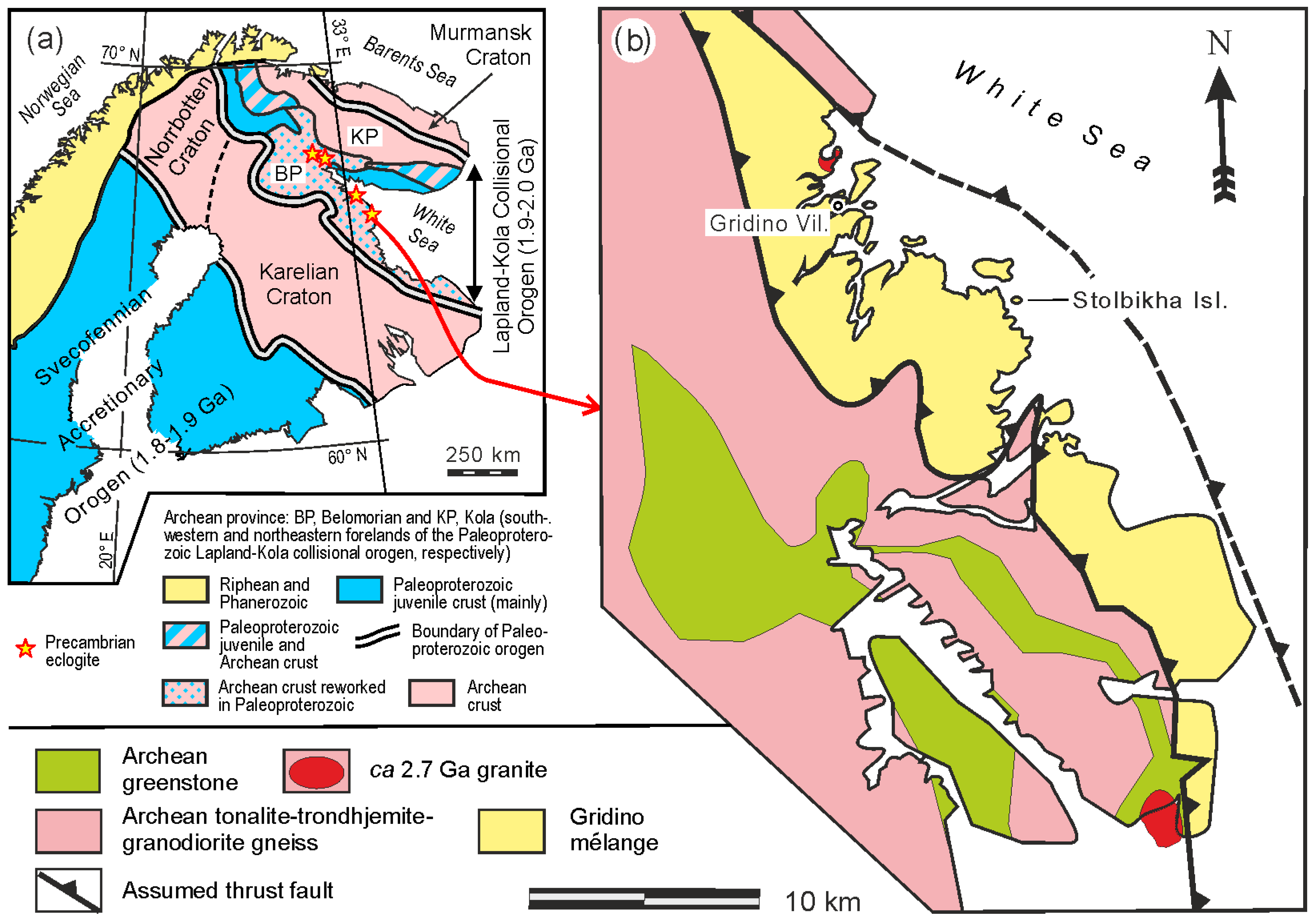
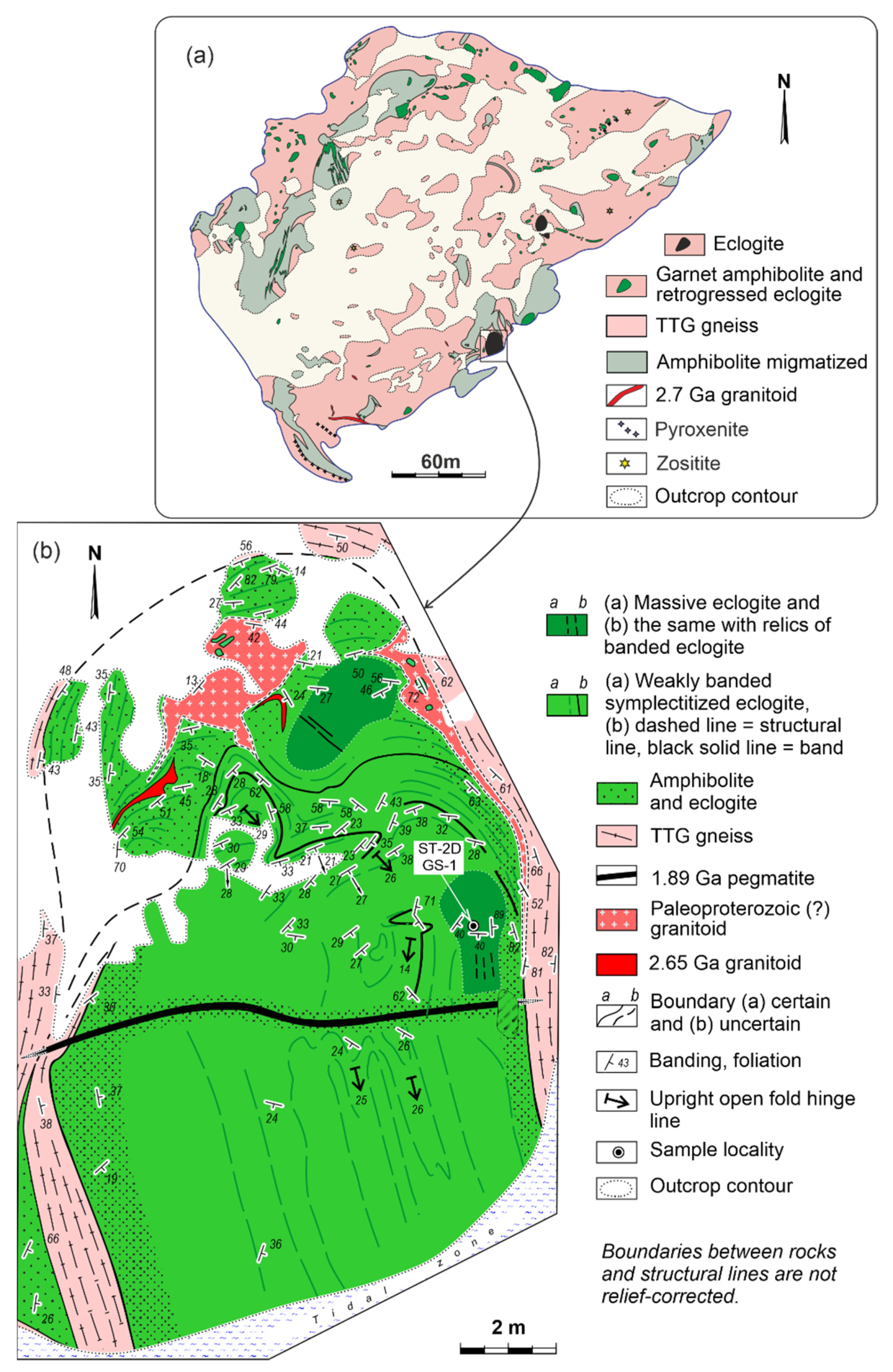
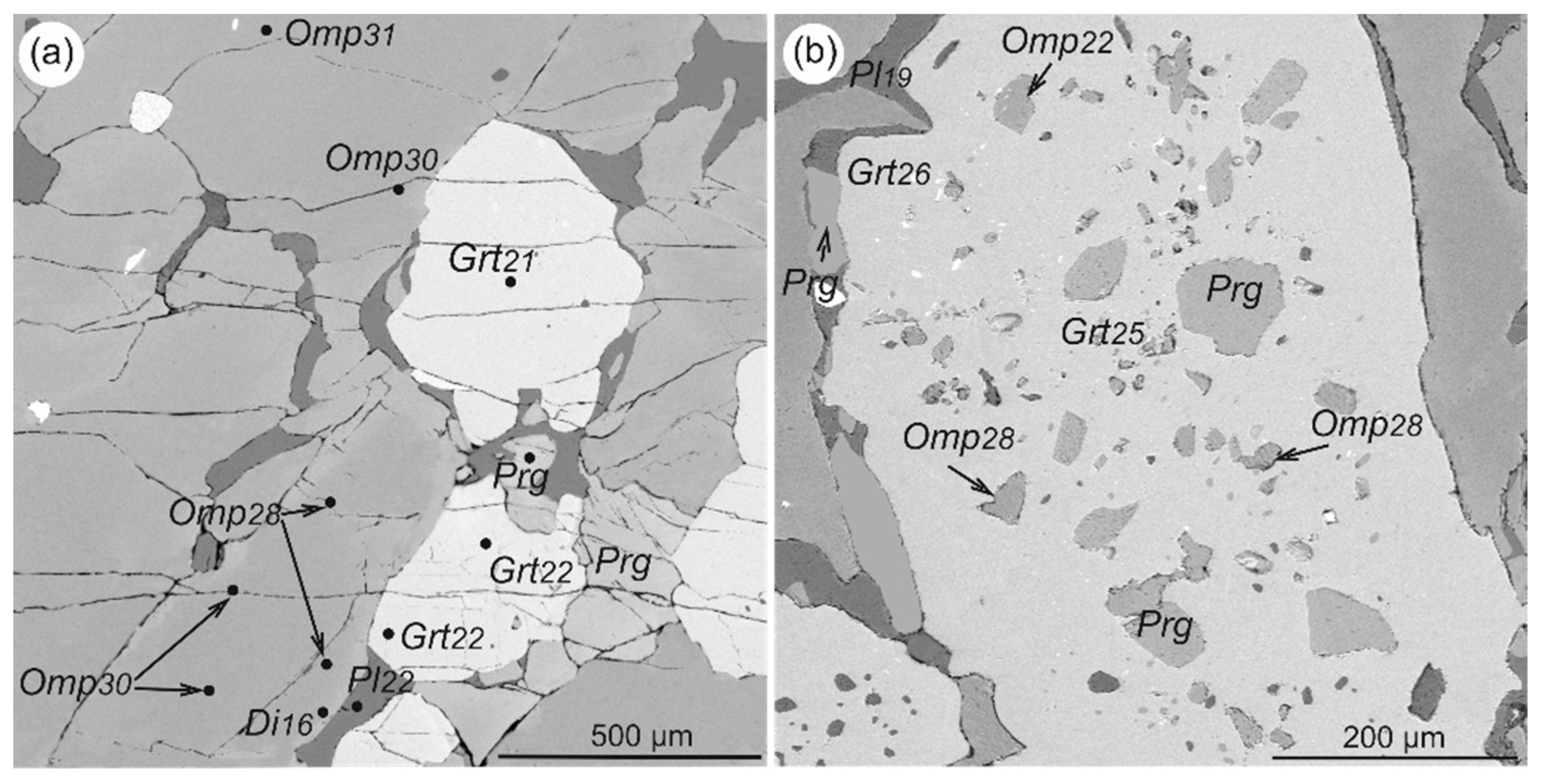
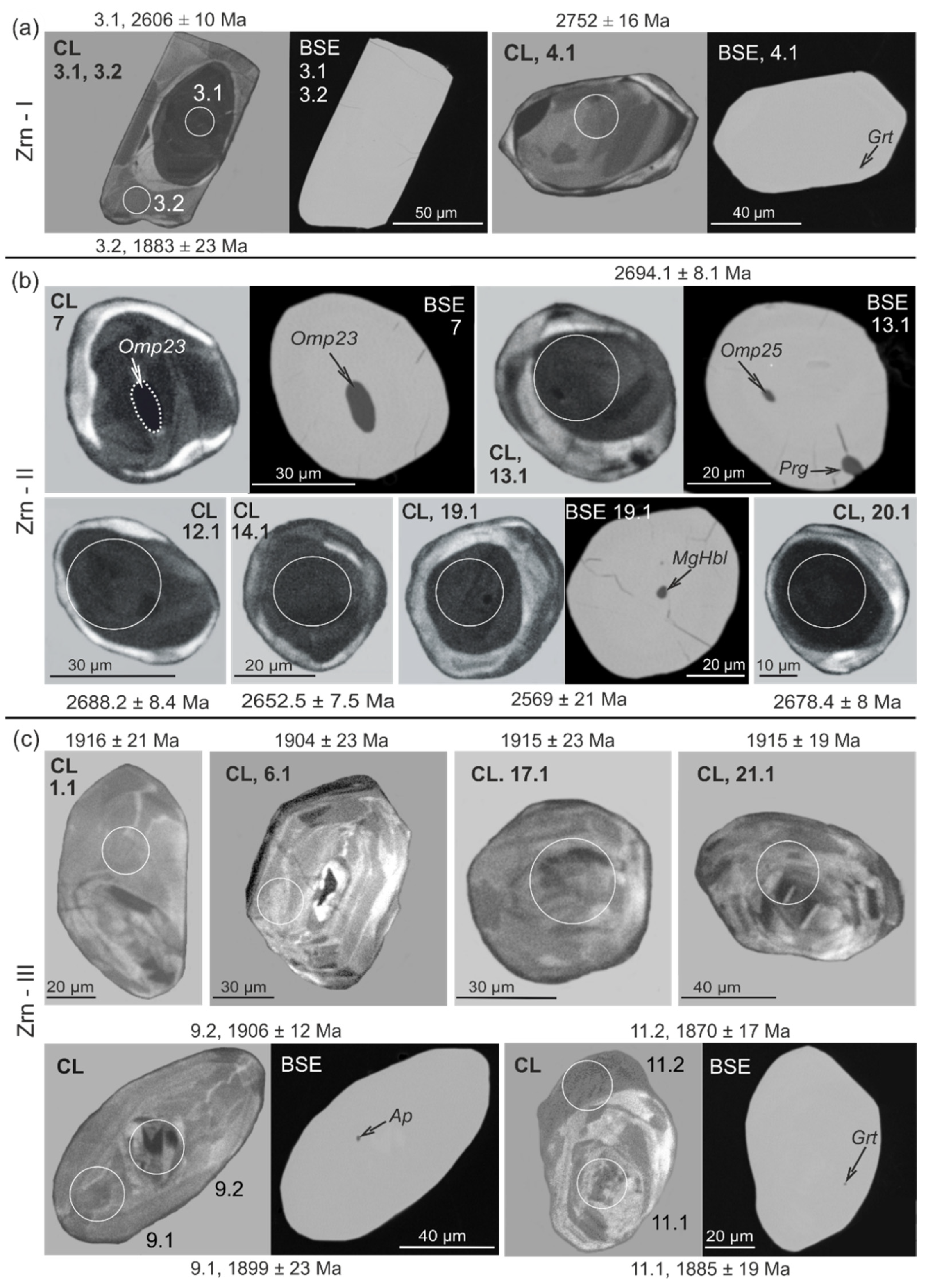
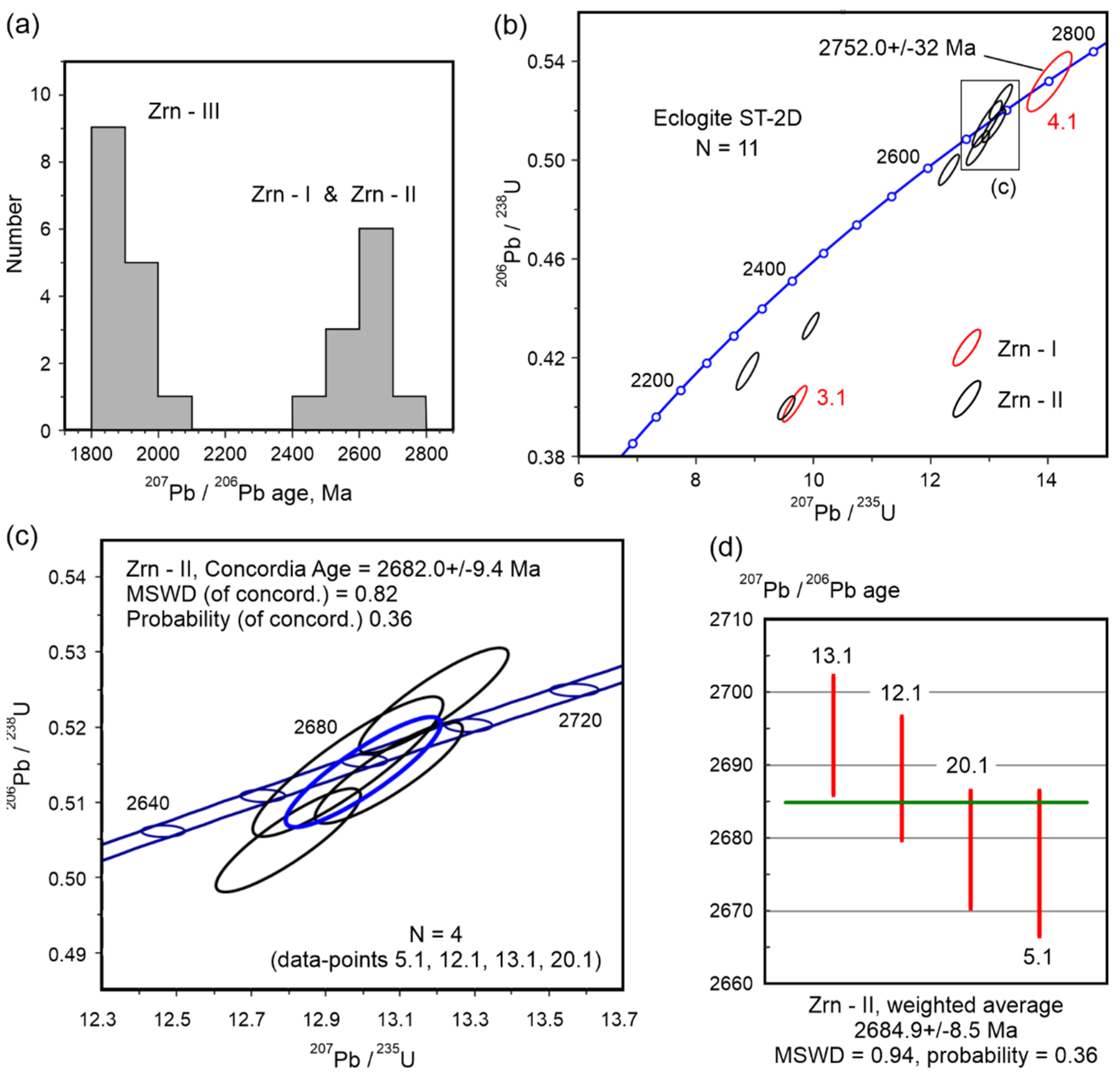
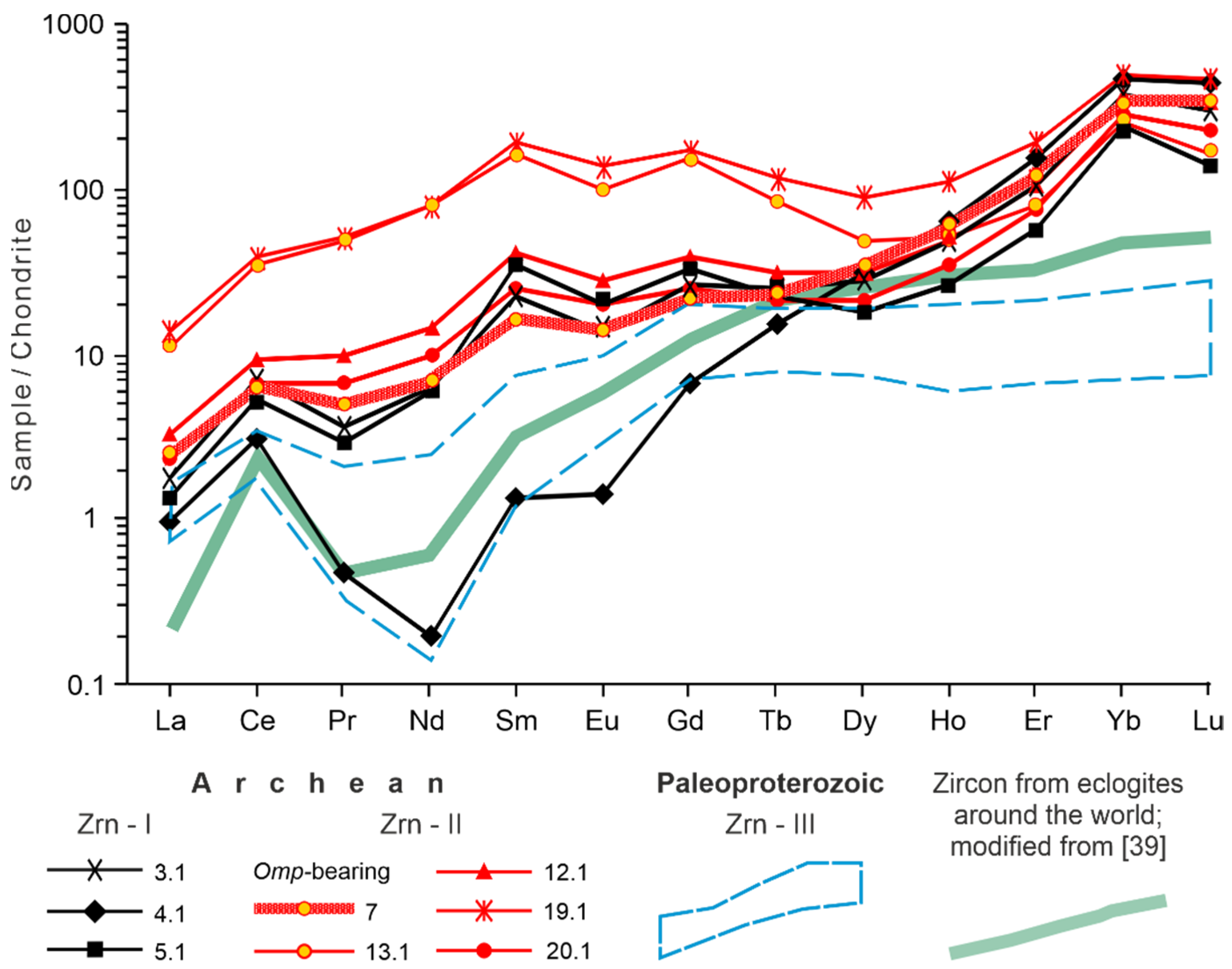
| Spot | 206Pbc, % | U, ppm | Th, ppm | 232Th/ 238U | 206Pb*, ppm | Age, Ma (±1σ) | D, % | 207Pb*/ 235U | ±1σ, % | 206Pb*/ 238U | ±1σ, % | 238U/ 206Pb* | ±1σ, % | 207Pb*/ 206Pb* | ±1σ, % | Rho | |
|---|---|---|---|---|---|---|---|---|---|---|---|---|---|---|---|---|---|
| 206Pb/238U | 207Pb/206Pb | ||||||||||||||||
| Zrn-I group | |||||||||||||||||
| 3.1 | 0.20 | 203 | 20 | 0.10 | 70.2 | 2175 ± 22 | 2606 ± 10 | 20 | 9.68 | 1.4 | 0.4013 | 1.2 | 2.492 | 1.2 | 0.175 | 0.62 | 0.888 |
| 4.1 | 0.34 | 51 | 8 | 0.16 | 23.4 | 2749 ± 33 | 2752 ± 16 | 0 | 14.02 | 1.8 | 0.5319 | 1.5 | 1.88 | 1.5 | 0.1912 | 0.98 | 0.830 |
| 5.1 | 0.10 | 175 | 13 | 0.07 | 77.5 | 2677 ± 26 | 2676.5 ± 9.9 | 0 | 12.96 | 1.3 | 0.5147 | 1.2 | 1.943 | 1.2 | 0.1826 | 0.6 | 0.892 |
| Zrn-II group | |||||||||||||||||
| 10.2 | 0.27 | 178 | 14 | 0.08 | 63.4 | 2236 ± 22 | 2405 ± 11 | 8 | 8.87 | 1.4 | 0.4145 | 1.2 | 2.412 | 1.2 | 0.1553 | 0.65 | 0.877 |
| 12.1 | 0.04 | 204 | 33 | 0.17 | 88.3 | 2635 ± 20 | 2688.2 ± 8.4 | 2 | 12.8 | 1 | 0.5049 | 0.9 | 1.98 | 0.9 | 0.18388 | 0.51 | 0.872 |
| 13.1 | 0.30 | 232 | 48 | 0.21 | 103 | 2673 ± 19 | 2694.1 ± 8.1 | 1 | 13.07 | 1 | 0.5139 | 0.87 | 1.946 | 0.87 | 0.18454 | 0.49 | 0.872 |
| 14.1 | 0.03 | 264 | 54 | 0.21 | 113 | 2597 ± 18 | 2652.5 ± 7.5 | 2 | 12.31 | 0.94 | 0.4961 | 0.82 | 2.016 | 0.82 | 0.17996 | 0.45 | 0.877 |
| 15.1 | 0.17 | 412 | 76 | 0.19 | 142 | 2167 ± 15 | 2588 ± 11 | 19 | 9.537 | 1 | 0.3996 | 0.79 | 2.503 | 0.79 | 0.1731 | 0.65 | 0.770 |
| 18.1 | 0.07 | 343 | 70 | 0.21 | 128 | 2318 ± 16 | 2524.7 ± 7.4 | 9 | 9.948 | 0.92 | 0.4328 | 0.8 | 2.31 | 0.8 | 0.16669 | 0.44 | 0.876 |
| 19.1 | 1.24 | 335 | 50 | 0.16 | 106 | 2004 ± 34 | 2569 ± 21 | 28 | 8.61 | 2.4 | 0.3647 | 2 | 2.742 | 2 | 0.1711 | 1.3 | 0.844 |
| 20.1 | 0.05 | 216 | 23 | 0.11 | 97.4 | 2714 ± 20 | 2678.4 ± 8 | −1 | 13.19 | 1 | 0.5235 | 0.89 | 1.91 | 0.89 | 0.18279 | 0.48 | 0.880 |
| Zircon Group | Zrn–I | Zrn–II | ||||||
|---|---|---|---|---|---|---|---|---|
| Spot | 3.1 | 4.1 | 5.1 | 12.1 | 13.1 | 14.1 | 19.1 | 20.1 |
| La | 0.58 | 0.326 | 0.447 | 1.05 | 3.68 | 4.46 | 4.48 | 0.753 |
| Ce | 6.01 | 2.62 | 4.55 | 7.91 | 29.8 | 28.2 | 33.3 | 5.62 |
| Pr | 0.468 | 0.0614 | 0.381 | 1.28 | 6.40 | 7.11 | 6.74 | 0.859 |
| Nd | 3.88 | 0.125 | 3.80 | 8.94 | 49.8 | 50.3 | 49.5 | 6.23 |
| Sm | 4.61 | 0.276 | 7.20 | 8.41 | 33.7 | 38.3 | 38.2 | 5.06 |
| Eu | 1.07 | 0.112 | 1.57 | 2.19 | 7.58 | 9.95 | 10.3 | 1.55 |
| Gd | 7.34 | 1.79 | 9.19 | 10.9 | 42 | 43.2 | 48.4 | 6.86 |
| Tb | 1.23 | 0.755 | 1.13 | 1.55 | 4.06 | 4.61 | 5.71 | 1.05 |
| Dy | 9.72 | 10.8 | 6.19 | 10.5 | 16.3 | 21.3 | 29.6 | 7.42 |
| Ho | 3.69 | 4.96 | 2.07 | 3.80 | 3.96 | 5.60 | 8.40 | 2.69 |
| Er | 23.5 | 33.5 | 13 | 23.3 | 17.5 | 27.7 | 42.4 | 17.2 |
| Yb | 80.8 | 98.7 | 53.3 | 76.9 | 54.9 | 83.7 | 109 | 62.2 |
| Lu | 10.1 | 15 | 4.72 | 11 | 5.47 | 11.2 | 15.5 | 7.73 |
| Y | 118 | 168 | 68.3 | 121 | 126 | 185 | 251 | 91.9 |
| Ti | 10.3 | 7.75 | 8.40 | 7.83 | 14.6 | 7.69 | 185 | 6.21 |
| Eu/Eu* | 0.57 | 0.49 | 0.59 | 0.70 | 0.62 | 0.75 | 0.74 | 0.81 |
| Ce/Ce* | 2.76 | 4.43 | 2.64 | 1.63 | 1.47 | 1.20 | 1.45 | 1.67 |
| ∑REE | 153.00 | 169.03 | 107.55 | 167.73 | 275.15 | 335.63 | 401.53 | 125.22 |
| ∑LREE | 16.62 | 3.52 | 17.95 | 29.78 | 130.96 | 138.32 | 142.52 | 20.07 |
| ∑HREE | 136.38 | 165.51 | 89.60 | 137.95 | 144.19 | 197.31 | 259.01 | 105.15 |
| LuN/LaN | 169.00 | 446.55 | 102.48 | 101.67 | 14.43 | 24.37 | 33.58 | 99.63 |
| LuN/GdN | 11.20 | 68.23 | 4.18 | 8.22 | 1.06 | 2.11 | 2.61 | 9.17 |
| SmN/LaN | 12.88 | 1.37 | 26.11 | 12.98 | 14.84 | 13.92 | 13.82 | 10.89 |
| 207Pb/206Pb age, Ma | 2606 ± 10 | 2752 ± 16 | 2676.5 ± 9.9 | 2688.2 ± 8.4 | 2694.1 ± 8.1 | 2652.5 ± 7.5 | 2569 ± 21 | 2678.4 ± 8 |
| T, °C | 743 | 719 | 726 | 720 | 775 | 718 | 1084 | 701 |
| Data-Point | 7 | 13.1 |
|---|---|---|
| SiO2 | 53.15 | 55.28 |
| Al2O3 | 8.00 | 6.56 |
| FeO* | 6.60 | 5.12 |
| MgO | 10.48 | 11.93 |
| CaO | 18.50 | 17.44 |
| Na2O | 3.26 | 3.65 |
| Total | 99.99 | 99.98 |
| O | 6 | 6 |
| Si | 1.94 | 2.00 |
| Al (IV) | 0.06 | 0 |
| Al (VI) | 0.28 | 0.28 |
| Fe3+ | 0.01 | 0 |
| Fe2+ | 0.19 | 0.15 |
| Mg | 0.57 | 0.64 |
| Ca | 0.72 | 0.67 |
| Na | 0.23 | 0.26 |
| cation sum | 4.00 | 4.00 |
| Mg# | 0.74 | 0.81 |
| Jadeite | 23.0 | 25.4 |
| Acmite | 0 | 0 |
| Augite | 77.0 | 74.6 |
Publisher’s Note: MDPI stays neutral with regard to jurisdictional claims in published maps and institutional affiliations. |
© 2021 by the authors. Licensee MDPI, Basel, Switzerland. This article is an open access article distributed under the terms and conditions of the Creative Commons Attribution (CC BY) license (https://creativecommons.org/licenses/by/4.0/).
Share and Cite
Volodichev, O.I.; Maksimov, O.A.; Kuzenko, T.I.; Slabunov, A.I. Archean Zircons with Omphacite Inclusions from Eclogites of the Belomorian Province, Fennoscandian Shield: The First Finding. Minerals 2021, 11, 1029. https://doi.org/10.3390/min11101029
Volodichev OI, Maksimov OA, Kuzenko TI, Slabunov AI. Archean Zircons with Omphacite Inclusions from Eclogites of the Belomorian Province, Fennoscandian Shield: The First Finding. Minerals. 2021; 11(10):1029. https://doi.org/10.3390/min11101029
Chicago/Turabian StyleVolodichev, Oleg I., Oleg A. Maksimov, Tatiana I. Kuzenko, and Alexander I. Slabunov. 2021. "Archean Zircons with Omphacite Inclusions from Eclogites of the Belomorian Province, Fennoscandian Shield: The First Finding" Minerals 11, no. 10: 1029. https://doi.org/10.3390/min11101029
APA StyleVolodichev, O. I., Maksimov, O. A., Kuzenko, T. I., & Slabunov, A. I. (2021). Archean Zircons with Omphacite Inclusions from Eclogites of the Belomorian Province, Fennoscandian Shield: The First Finding. Minerals, 11(10), 1029. https://doi.org/10.3390/min11101029







